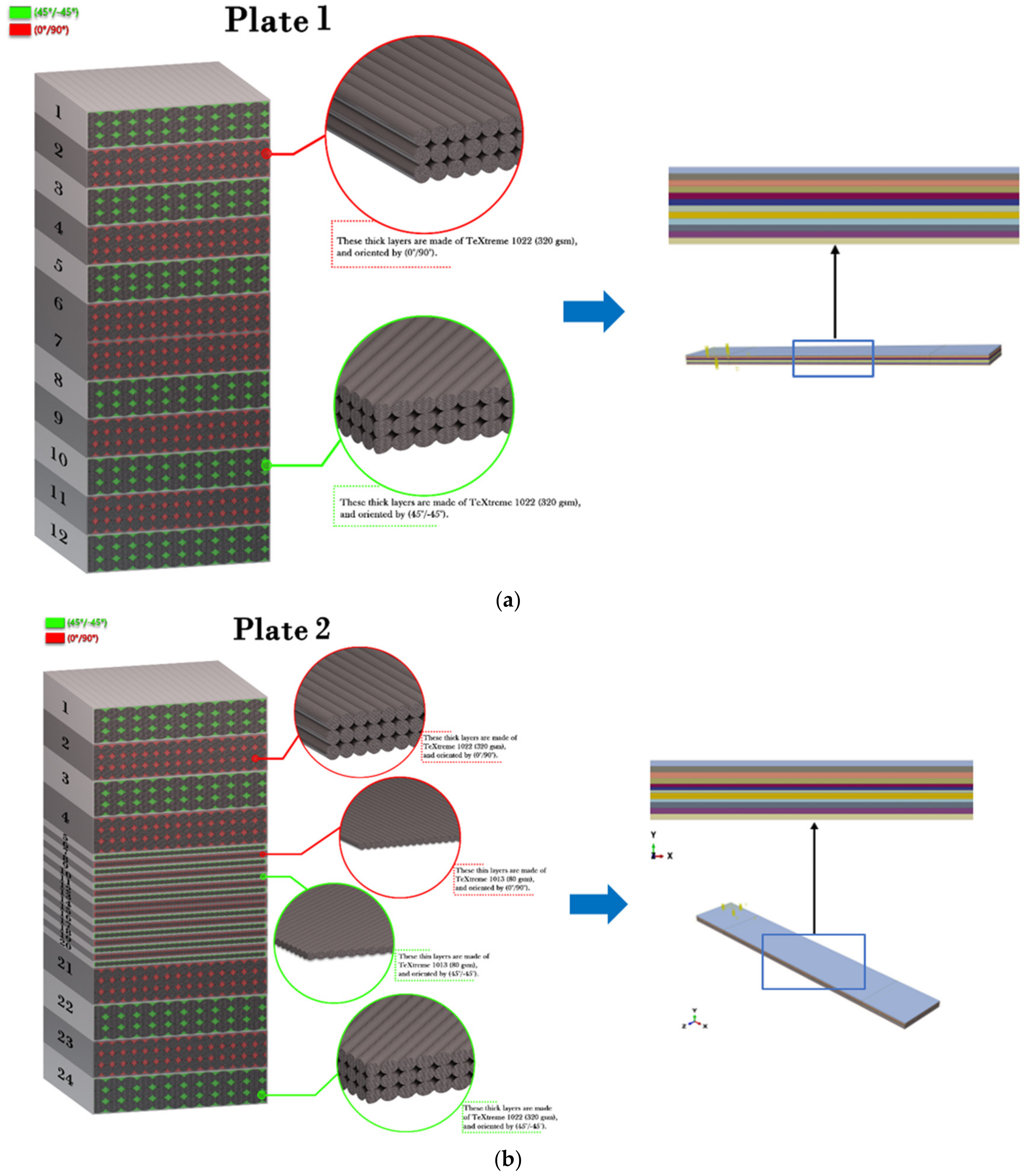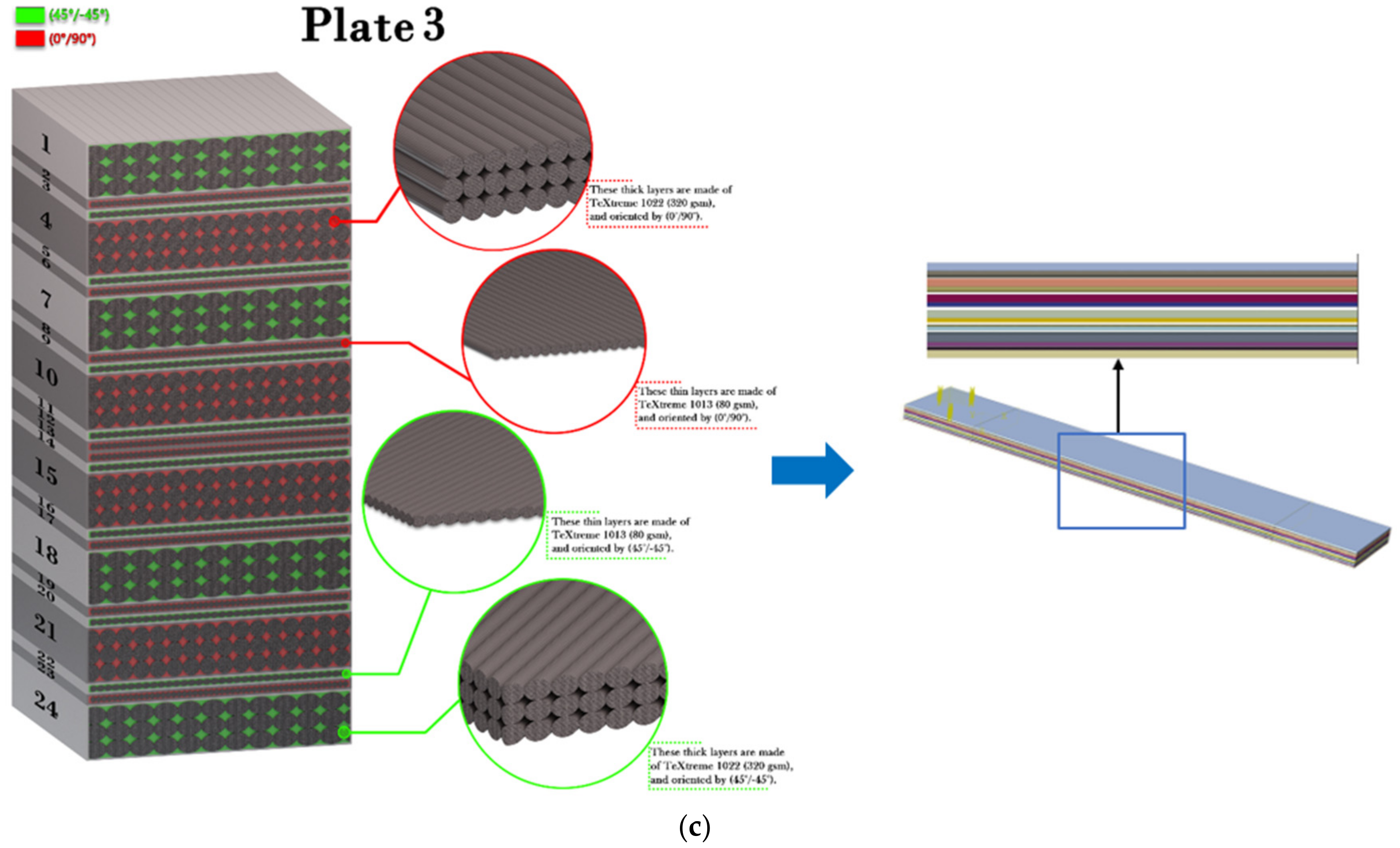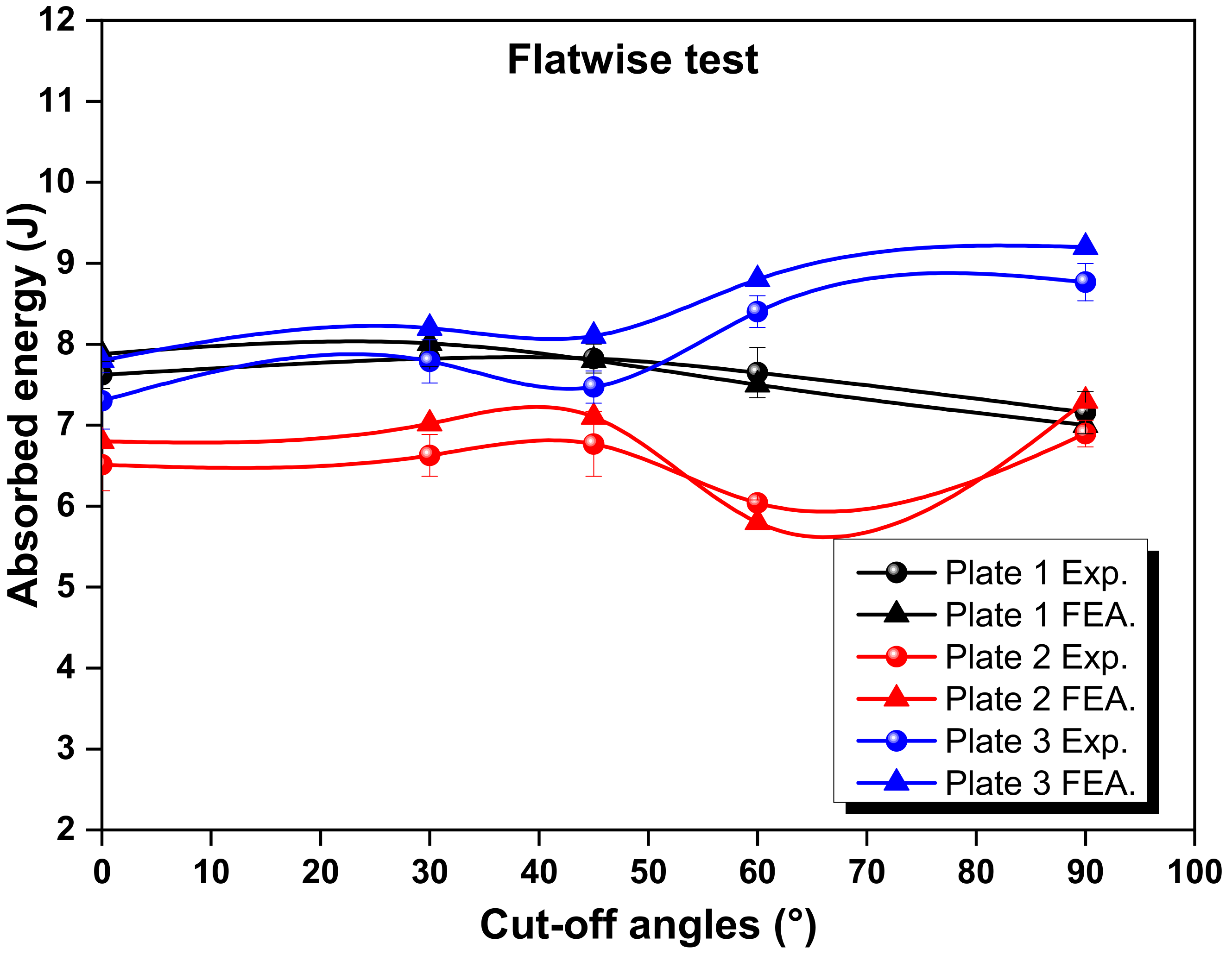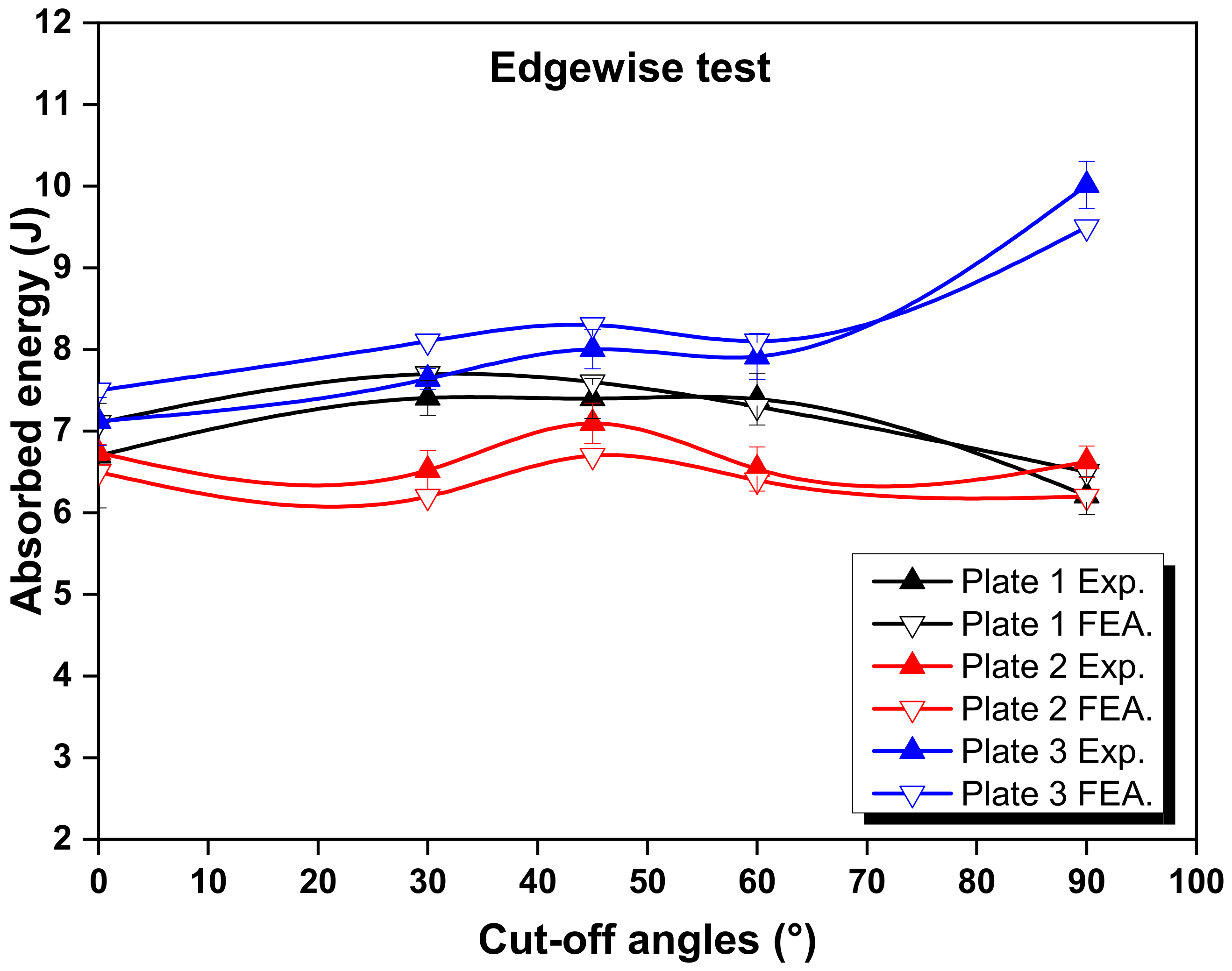Effect of Embedded Thin-Plies on the Charpy Impact Properties of CFRP Composites
Abstract
1. Introduction
2. Materials and Method
2.1. Materials and Sample Preparation
2.2. Charpy Impact Test
2.3. Finite Element Analysis
3. Results and Discussion
3.1. Absorbed Energy
3.2. Damage Assessment
3.3. Validity of FEM Results
4. Conclusions
- (i)
- The absorbed impact energy was significantly influenced by the hybridisation and the hybrid plies did not show any delamination effects due to poor adhesion;
- (ii)
- The integration of thin plies that were made from fabric–epoxy composites in between each traditional ply increased the absorbed energy by up to 10 J for the edgewise configuration at a cut-off angle of 90°, whereas the flatwise energy absorption was recorded as 8.7 J;
- (iii)
- For Plates 1 and 2, the cut-off angle of 45° seemed to produce higher energy absorption. However, for the Plate 3 configuration, a cut-off angle of 90° outperformed the others in terms of energy absorption;
- (iv)
- The damage assessments showed the increased damage prevention of the hybrid thin ply composites because they distributed the stress more uniformly, whereas the traditional ply composites incurred large deformations from the impact loads;
- (v)
- The FEM model was capable of accurately predicting the absorbed energy for the different configurations of composites that were prepared and analysed. Both experimental and numerical values were very similar;
- (vi)
- The proposed hybrid composite laminates could be useful due to their improved impact energy and the existing models. However, the ply configuration could be optimised for other potential applications wherever possible.
Author Contributions
Funding
Institutional Review Board Statement
Informed Consent Statement
Data Availability Statement
Acknowledgments
Conflicts of Interest
References
- Guo, R.; Xian, G.; Li, C.; Huang, X.; Xin, M. Effect of fiber hybridization types on the mechanical properties of carbon/glass fiber reinforced polymer composite rod. Mech. Adv. Mater. Struct. 2021, 9, 1–13. [Google Scholar] [CrossRef]
- Ganesan, C.; Joanna, P.; Singh, D. Fatigue life modeling of FRP composites: A comprehensive review. Mater. Today Proc. 2021, 46, 555–561. [Google Scholar] [CrossRef]
- Xian, G.; Guo, R.; Li, C. Combined effects of sustained bending loading, water immersion and fiber hybrid mode on the mechanical properties of carbon/glass fiber reinforced polymer composite. Compos. Struct. 2022, 281, 115060. [Google Scholar] [CrossRef]
- Fotouhi, M.; Jalalvand, M.; Wisnom, M.R. High performance quasi-isotropic thin-ply carbon/glass hybrid composites with pseudo-ductile behaviour in all fibre orientations. Compos. Sci. Technol. 2017, 152, 101–110. [Google Scholar] [CrossRef]
- Czél, G.; Jalalvand, M.; Wisnom, M.R. Design and characterisation of advanced pseudo-ductile unidirectional thin-ply carbon/epoxy-glass/epoxy hybrid composites. Compos. Struct. 2016, 143, 362–370. [Google Scholar] [CrossRef]
- Mania, R.; York, C. Buckling strength improvements for Fibre Metal Laminates using thin-ply tailoring. Compos. Struct. 2017, 159, 424–432. [Google Scholar] [CrossRef][Green Version]
- Alshahrani, H.A. Sensitivity of woven textile sandwich panel faces to Charpy impact properties. Mater. Res. Express 2021, 8, 065603. [Google Scholar] [CrossRef]
- Galos, J. Thin-ply composite laminates: A review. Compos. Struct. 2020, 236, 111920. [Google Scholar] [CrossRef]
- Arteiro, A.; Furtado, C.; Catalanotti, G.; Linde, P.; Camanho, P. Thin-ply polymer composite materials: A review. Compos. Part A Appl. Sci. Manuf. 2020, 132, 105777. [Google Scholar] [CrossRef]
- Prakash, V.A.; Rajadurai, A. Thermo-mechanical characterization of siliconized E-glass fiber/hematite particles reinforced epoxy resin hybrid composite. Appl. Surf. Sci. 2016, 384, 99–106. [Google Scholar]
- Shah, S.; Karuppanan, S.; Megat-Yusoff, P.; Sajid, Z. Impact resistance and damage tolerance of fiber reinforced composites: A review. Compos. Struct. 2019, 217, 100–121. [Google Scholar] [CrossRef]
- Ghaith, F.A. Nonlinear Finite Element Modeling of Charpy Impact Test. Adv. Mater. Res. 2010, 83–86, 182–189. [Google Scholar] [CrossRef]
- Yokozeki, T.; Aoki, Y.; Ogasawara, T. Experimental characterization of strength and damage resistance properties of thin-ply carbon fiber/toughened epoxy laminates. Compos. Struct. 2008, 82, 382–389. [Google Scholar] [CrossRef]
- Sihn, S.; Kim, R.Y.; Kawabe, K.; Tsai, S.W. Experimental studies of thin-ply laminated composites. Compos. Sci. Technol. 2007, 67, 996–1008. [Google Scholar] [CrossRef]
- Yokozeki, T.; Kuroda, A.; Yoshimura, A.; Ogasawara, T.; Aoki, T. Damage characterization in thin-ply composite laminates under out-of-plane transverse loadings. Compos. Struct. 2010, 93, 49–57. [Google Scholar] [CrossRef]
- Saito, H.; Morita, M.; Kawabe, K.; Kanesaki, M.; Takeuchi, H.; Tanaka, M.; Kimpara, I. Effect of ply-thickness on impact damage morphology in CFRP laminates. J. Reinf. Plast. Compos. 2011, 30, 1097–1106. [Google Scholar] [CrossRef]
- Arteiro, A.; Catalanotti, G.; Xavier, J.; Camanho, P. Large damage capability of non-crimp fabric thin-ply laminates. Compos. Part A Appl. Sci. Manuf. 2014, 63, 110–122. [Google Scholar] [CrossRef]
- Sebaey, T.; Mahdi, E. Using thin-plies to improve the damage resistance and tolerance of aeronautical CFRP composites. Compos. Part A Appl. Sci. Manuf. 2016, 86, 31–38. [Google Scholar] [CrossRef]
- Sasikumar, A.; Trias, D.; Costa, J.; Blanco, N.; Orr, J.; Linde, P. Effect of ply thickness and ply level hybridization on the compression after impact strength of thin laminates. Compos. Part A Appl. Sci. Manuf. 2019, 121, 232–243. [Google Scholar] [CrossRef]
- Soto, A.; González, E.V.; Maimí, P.; de la Escalera, F.M.; de Aja, J.S.; Alvarez, E. Low velocity impact and compression after impact simulation of thin ply laminates. Compos. Part A Appl. Sci. Manuf. 2018, 109, 413–427. [Google Scholar] [CrossRef]
- Droździel, M.; Jakubczak, P.; Bieniaś, J. Low-velocity impact resistance of thin-ply in comparison with conventional aluminium-carbon laminates. Compos. Struct. 2021, 256, 113083. [Google Scholar] [CrossRef]
- Caminero, M.A.; Rodríguez, G.; Muñoz, V. Effect of stacking sequence on Charpy impact and flexural damage behavior of composite laminates. Compos. Struct. 2016, 136, 345–357. [Google Scholar] [CrossRef]
- Wagih, A.; Maimí, P.; González, E.V.; Blanco, N.; de Aja, J.S.; de la Escalera, F.; Olsson, R.; Alvarez, E. Damage sequence in thin-ply composite laminates under out-of-plane loading. Compos. Part A Appl. Sci. Manuf. 2016, 87, 66–77. [Google Scholar] [CrossRef]
- Naderi, M.; Iyyer, N. Micromechanical analysis of damage mechanisms under tension of 0–90° thin-ply composite laminates. Compos. Struct. 2020, 234, 111659. [Google Scholar] [CrossRef]
- achariah, S.A.; Shenoy, B.S.; Jayan, J.; Pai, K.D. Experimental investigation on dynamic and static transverse behaviour of thin woven Carbon/Aramid hybrid laminates. J. King Saud Univ. Eng. Sci. 2020, in press. [Google Scholar]
- Sebaey, T.A.; González, E.V.; Lopes, C.S.; Blanco, N.; Maimí, P.; Costa, J. Damage resistance and damage tolerance of dispersed CFRP laminates: Effect of the mismatch angle between plies. Compos. Struct. 2013, 101, 255–264. [Google Scholar] [CrossRef]
- Prakash, V.A.; Viswanthan, R. Fabrication and characterization of echinoidea spike particles and kenaf natural fibre-reinforced Azadirachta-Indica blended epoxy multi-hybrid bio composite. Compos. Part A Appl. Sci. Manuf. 2019, 118, 317–326. [Google Scholar] [CrossRef]
- Ramesh, C.; Manickam, C.; Maridurai, T.; Prakash, V.R. Dry sliding wear characteristics of heat treated and surface modified hematite particles-EPDXY particulate composite. Rom. J. Mater. 2017, 47, 401–405. [Google Scholar]
- Balakrishnan, P.; John, M.J.; Pothen, L.; Sreekala, M.S.; Thomas, S. Natural Fibre and Polymer Matrix Composites and Their Applications in Aerospace Engineering. In Advanced Composite Materials for Aerospace Engineering; Woodhead Publishing: Cambridge, UK, 2016; pp. 365–383. [Google Scholar] [CrossRef]
- Graupner, N.; Kühn, N.; Müssig, J. Influence of sample thickness, curvature and notches on the Charpy impact strength-An approach to standardise the impact strength of curved test specimens and biological structures. Polym. Test. 2021, 93, 106864. [Google Scholar] [CrossRef]
- Qin, G.; Na, J.; Mu, W.; Tan, W.; Yang, J.; Ren, J. Effect of continuous high temperature exposure on the adhesive strength of epoxy adhesive, CFRP and adhesively bonded CFRP-aluminum alloy joints. Compos. Part B Eng. 2018, 154, 43–55. [Google Scholar] [CrossRef]
- Jojibabu, P.; Zhang, Y.; Prusty, B.G. A review of research advances in epoxy-based nanocomposites as adhesive materials. Int. J. Adhes. Adhes. 2020, 96, 102454. [Google Scholar] [CrossRef]
- Murugan, M.A.; Jayaseelan, V.; Jayabalakrishnan, D.; Maridurai, T.; Kumar, S.S.; Ramesh, G.; Prakash, V.R.A. Low Velocity Impact and Mechanical Behaviour of Shot Blasted SiC Wire-Mesh and Silane-Treated Aloevera/Hemp/Flax-Reinforced SiC Whisker Modified Epoxy Resin Composites. Silicon 2020, 12, 1847–1856. [Google Scholar] [CrossRef]
- Mousavi-Bafrouyi, S.S.; Eslami-Farsani, R.; Geranmayeh, A. Effect of stacking sequence on the mechanical properties of pseudo-ductile thin-ply unidirectional carbon-basalt fibers/epoxy composites. J. Ind. Text. 2020, in press. [Google Scholar] [CrossRef]
- Quan, D.; Deegan, B.; Binsfeld, L.; Li, X.; Atkinson, J.; Ivanković, A.; Murphy, N. Effect of interlaying UV-irradiated PEEK fibres on the mechanical, impact and fracture response of aerospace-grade carbon fibre/epoxy composites. Compos. Part B Eng. 2020, 191, 107923. [Google Scholar] [CrossRef]
- Vincent, V.A.; Kailasanathan, C.; Shanmuganathan, V.K.; Kumar, J.V.; Arun Prakash, V.R. Strength characterization of caryota urens fibre and aluminium 2024-T3 foil multi-stacking sequenced SiC-toughened epoxy structural composite. Biomass Convers. Biorefinery 2020, 1–11. [Google Scholar] [CrossRef]
- Pakkam Gabriel, V.R.; Loukil, M.S.; Varna, J. Analysis of intralaminar cracking in 90-plies of GF/EP laminates with distributed ply strength. J. Compos. Mater. 2021, 55, 3925–3942. [Google Scholar] [CrossRef]
- Li, Z.; Zhang, J.; Jackstadt, A.; Kärger, L. Low-velocity impact behavior of hybrid CFRP-elastomer-metal laminates in comparison with conventional fiber-metal laminates. Compos. Struct. 2022, 287, 115340. [Google Scholar] [CrossRef]
- Mencattelli, L.; Pinho, S.T. Herringbone-Bouligand CFRP structures: A new tailorable damage-tolerant solution for damage containment and reduced delaminations. Compos. Sci. Technol. 2020, 190, 108047. [Google Scholar] [CrossRef]
- Prakash, V.R.; Julyes Jaisingh, S. Mechanical strength behaviour of silane treated E-glass fibre/Al 6061 & SS-304 wire mesh reinforced epoxy resin hybrid composite. Silicon 2018, 10, 2279–2286. [Google Scholar]
- Manikandan, G.; Jaiganesh, V.; Malarvannan, R.R.; Prakash, A.V. Mechanical and delamination studies on siliconized chitosan and morinda-citrifolia natural fiber-reinforced epoxy composite in drilling. Polym. Compos. 2021, 42, 181–190. [Google Scholar]
- Prakash, V.A.; Rajadurai, A. Inter laminar shear strength behavior of acid, base and silane treated E-glass fibre epoxy resin composites on drilling process. Def. Technol. 2017, 13, 40–46. [Google Scholar] [CrossRef]
- Hou, Y.; Tie, Y.; Li, C.; Sapanathan, T.; Rachik, M. Low-velocity impact behaviors of repaired CFRP laminates: Effect of impact location and external patch configurations. Compos. Part B Eng. 2019, 163, 669–680. [Google Scholar] [CrossRef]
- Alshahrani, H.; Ahmed, A. Enhancing Impact Energy Absorption, Flexural and Crash Performance Properties of Automotive Composite Laminates by Adjusting the Stacking Sequences Layup. Polymers 2021, 13, 3404. [Google Scholar] [CrossRef] [PubMed]
- Gokuldass, R.; Ramesh, R. Mechanical and low velocity impact behaviour of intra-ply glass/kevlar fibre reinforced nano-silica and micro-rubber modified epoxy resin hybrid composite. Mater. Res. Express 2019, 6, 055302. [Google Scholar] [CrossRef]





| No. | Property | Unit | Value |
|---|---|---|---|
| 1 | Strength of fibre (σf) | GPa | 3.1–3.3 |
| 2 | Strength of matrix (σm) | MPa | 60–66 |
| 3 | Density of fibre (ρf) | g/cm3 | 1.75–1.93 |
| 4 | Density of matrix (ρm) | g/cm3 | 1.18–1.20 |
| 5 | Longitudinal stiffness (E11) | GPa | 73–75 |
| 6 | Transverse stiffness (E22) | GPa | 7.733–7.92 |
| 7 | Out-of-plane stiffness (E33) | GPa | 7.733–7.76 |
| 8 | Poisson’s ratio (ν11) | 0.1 | |
| 9 | Poisson’s ratio (ν13) | 0.1 | |
| 10 | Poisson’s ratio (ν23) | 0.3 | |
| 11 | Shear modulus (G12) | GPa | 4.3–4.5 |
| 12 | Shear modulus (G13) | GPa | 4.3–4.5 |
| 13 | Shear modulus (G23) | GPa | 2.3–2.4 |
| 14 | Ply thickness | mm | 0.085–0.33 |
| 15 | Density of composite (ρ) | (kg/m3) | 1840 |
| Property | Value |
|---|---|
| Longitudinal stiffness, E (MPa) | 1.25 × 106 |
| Transverse stiffness, G1 (MPa) | 1.25 × 106 |
| Out-of-plane stiffness, G2 (MPa) | 1.25 × 106 |
| Nominal stress normal-only mode, N0 (MPa) | 71 |
| Nominal stress first direction, T0 (MPa) | 88 |
| Nominal stress second direction, S0 (MPa) | 88 |
| Normal mode fracture energy, G1c (N/mm) | 0.095 |
| Shear model fracture energy first direction, G2c (N/mm) | 0.686 |
| Shear model fracture energy second direction, G3c (N/mm) | 0.686 |
| Power, η | 1.45 |
| Plate 1 | |||||
|---|---|---|---|---|---|
| Cut-Off Angle | EXP. Flatwise Failure | FEA. Flatwise Failure |  | EXP. Edgewise Failure | FEA. Edgewise Failure |
| 0 |  |  |  |  | |
| 30 |  |  |  |  | |
| 45 |  |  |  |  | |
| 60 |  |  |  |  | |
| 90 |  |  |  |  | |
| Plate 2 | |||||
|---|---|---|---|---|---|
| Cut-Off Angle | EXP. Flatwise Failure | FEA. Flatwise Failure |  | EXP. Edgewise Failure | FEA. Edgewise Failure |
| 0 |  |  |  |  | |
| 30 |  |  |  |  | |
| 45 |  |  |  |  | |
| 60 |  |  |  |  | |
| 90 |  |  |  |  | |
| Plate 3 | |||||
|---|---|---|---|---|---|
| Cut-Off Angle | EXP. Flatwise Failure | FEA. Flatwise Failure |  | EXP. Edgewise Failure | FEA. Edgewise Failure |
| 0 |  |  |  |  | |
| 30 |  |  |  |  | |
| 45 |  |  |  |  | |
| 60 |  |  |  |  | |
| 90 |  |  |  |  | |
Publisher’s Note: MDPI stays neutral with regard to jurisdictional claims in published maps and institutional affiliations. |
© 2022 by the authors. Licensee MDPI, Basel, Switzerland. This article is an open access article distributed under the terms and conditions of the Creative Commons Attribution (CC BY) license (https://creativecommons.org/licenses/by/4.0/).
Share and Cite
Alshahrani, H.; Sebaey, T.A. Effect of Embedded Thin-Plies on the Charpy Impact Properties of CFRP Composites. Polymers 2022, 14, 1929. https://doi.org/10.3390/polym14091929
Alshahrani H, Sebaey TA. Effect of Embedded Thin-Plies on the Charpy Impact Properties of CFRP Composites. Polymers. 2022; 14(9):1929. https://doi.org/10.3390/polym14091929
Chicago/Turabian StyleAlshahrani, Hassan, and Tamer A. Sebaey. 2022. "Effect of Embedded Thin-Plies on the Charpy Impact Properties of CFRP Composites" Polymers 14, no. 9: 1929. https://doi.org/10.3390/polym14091929
APA StyleAlshahrani, H., & Sebaey, T. A. (2022). Effect of Embedded Thin-Plies on the Charpy Impact Properties of CFRP Composites. Polymers, 14(9), 1929. https://doi.org/10.3390/polym14091929







